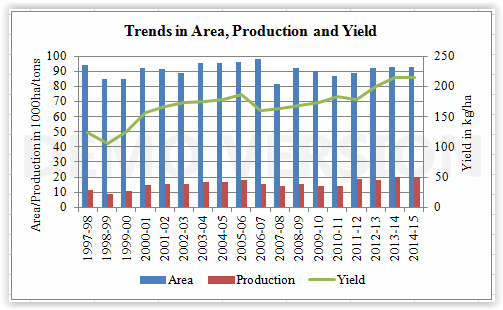|
|
Cardamom |
||||||||||||||||||||||||||||||
| 11 March 2015 05:17 PM | ||||||||||||||||||||||||||||||
|
Cardamom is an important spice, even referred as the queen of spices with its pleasant, sweet and subtle aroma as well as taste. It is the third most valued spice after Saffron and vanilla.
Indian sub-continent was the origin of cardamom. Cardamom was introduced to Guatemala in the early 20th century and Guatemala has now become the largest producer of cardamom in the world.
Broadly, there are two different types of cardamom- green and black. Green cardamom is also called true/small cardamom and is scientifically known as Elettaria cardamomum while black/brown/large cardamom is scientifically known as Amomum costatum and Amomum subulatum. It is reported that Green cardamom is a native of India and black cardamom is a native of Asia/Australia.
Economically important parts
Dried fruits and seeds are the economically important parts of the plant used for flavouring food either ground or whole.
Cardamom oil and oleoresins are used in flavouring processed food, cordials and ayurvedic medicines.
Climate and cultivation
Cardamom is a psiophytic plant, grown under the shade of trees in evergreen forests. It grows within an altitude of 600-1200 meters above mean sea level. It requires a well distributed rainfall of 150 to 250 cm with at least 20cm summer showers. Ideal temperature is 15-25oC.
Cardamom is propagated through seeds, suckers and tissue culture plantlets. The plants attain maturity in about 20-22 months. Economic production starts from 3rd year onwards and it continues up to 8-12 years with good management practices.
In India, it is largely grown in evergreen forests of the Western Ghats. Harvesting is done during August to March in about 6 pickings. However, peak harvesting season is September to November.
World Scenario
Major producing countries of cardamom in the world are Guatemala, India, Srilanka, Iran, Tanzania etc. However, major production is concentrated in Guatemala and India. Although there are no official estimates available, world cardamom production is estimated to be over 55000 MT. Of the total, Guatemala accounts for nearly30000 MT following by India with about 15000-18000 MT annually.
Domestic Scenario
India was the world’s largest producer of cardamom till 1970s. However, steep rise in production from Guatemala has pushed India to second place. But Indian cardamom is preferred by many countries for its flavour.
Cardamom production in India has been hovering around 15 to 18 thousand tons on averagee a year during past decade. However, in the recent years, cardamom production has been in the range of 20-25 thousand tons.
State-wise Production
Cardamom production is concentrated in Western Ghats of Southern states. Kerala alone accounts for about 75-80% of total cardamom production in the country followed by Karnataka with about 15-17 % and Tamil Nadu with 3-5%.
Small Cardamom Large Cardamom
Table 1: Trends in Balance Sheet of Cardamom (tons)
Source: Trade estimates
Major Markets
Spot Markets: Vandanamedu, Bodinayakanur, Kumily, Nedumkandom and Puliyanmala.
Futures Markets: Futures trading in Cardamom is offered on Multi Commodity Exchange of India Ltd (MCX).
External Trade
India consumes about 95% of its production and exports the rest. Nevertheless, India also imports cardamom though in minor quantities. But, qualitatively Indian cardamom is superior and hence there are selected buyers' pockets for it in the world market.
Major export destinations: Saudi Arabia, Pakistan, US, Kuwait, UAE, UK, Japan, Australia.
Major Import Sources: Nepal, Guatemala, Bhutan and Srilanka.
Factors Influencing Prices
|



